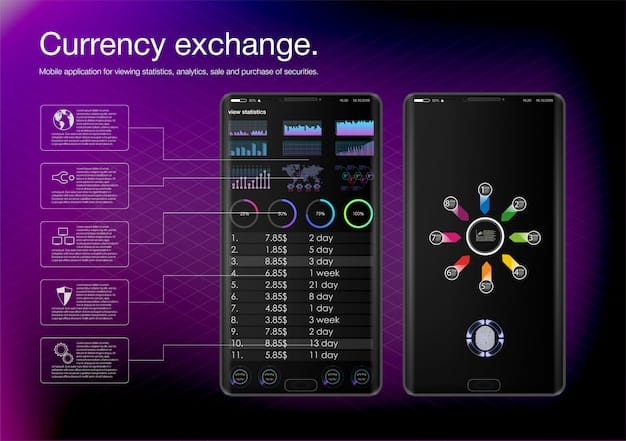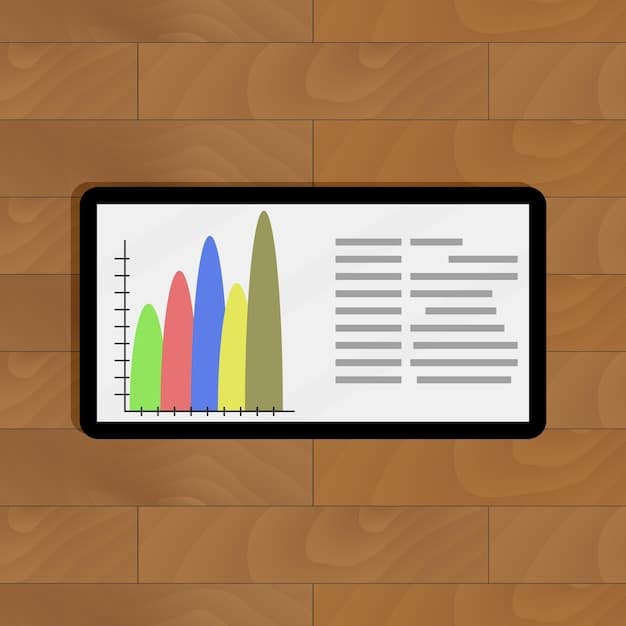Money-Saving Apps 2025: Are They Still Worth It?

Examining the financial landscape of 2025, this data-driven review evaluates whether popular money-saving apps continue to offer tangible benefits, considering evolving economic conditions, user data privacy, and technological advancements to help consumers make informed financial decisions.
The financial world is perpetually in motion, and what was revolutionary yesterday might be commonplace—or even obsolete—today. In an era where every penny counts and digital tools promise endless convenience, a critical question emerges: Are These Money-Saving Apps Still Worth It in 2025? A Data-Driven Review aims to cut through the noise, offering an expert perspective on the continued relevance and effectiveness of these digital financial companions.
The Evolving Landscape of Personal Finance Technology
In recent years, personal finance has undergone a significant digital transformation. From budgeting tools to investment platforms, apps have democratized access to financial management. However, the rapid pace of technological change and shifting economic climates necessitate a re-evaluation of their true value. Are they still delivering on their promises, or have they become more of a digital habit than a genuine asset?
Understanding this evolution is crucial for consumers seeking to optimize their financial well-being. The initial allure of convenience and automation might overshadow underlying issues such as data security, subscription costs, or diminishing returns. Our analysis delves into these factors, providing clarity on which apps continue to merit a place on your smartphone.
The Shift Towards Integrated Financial Ecosystems
Initially, many money-saving apps specialized in single functions, such as tracking expenses or finding coupon codes. However, 2025 sees a strong trend towards integrated financial ecosystems. These platforms aim to be a one-stop shop for budgeting, investing, saving, and even micro-lending, offering a more holistic view of one’s finances.
- Increased user convenience through centralized data.
- Potential for personalized financial advice and automation.
- Risk of vendor lock-in and complex data sharing agreements.
- Enhanced security measures required for comprehensive platforms.
This integration promises greater efficiency but also raises questions about data privacy and the potential for a single point of failure. Users are increasingly scrutinizing how their aggregated financial data is used and protected, moving beyond just convenience to consider security and ethical data handling methods.
The consumer’s perception of “value” is no longer just about savings, but also ease of use, data protection, and the ability of an app to adapt to their changing financial circumstances. Apps that fail to innovate or adequately protect user information will quickly lose appeal, regardless of their past performance.
Budgeting Apps: Still the Cornerstone of Financial Management?
Budgeting apps have long been hailed as essential for financial discipline. Tools like Mint, YNAB (You Need A Budget), and PocketGuard have helped millions track their spending and set financial goals. But as digital banking becomes more sophisticated and offers built-in budgeting features, do dedicated apps still provide a compelling advantage in 2025?
While many banks now offer basic spending categorization and alerts, dedicated budgeting apps often provide deeper analytical insights, customizable categories, and more robust goal-setting features. They aggregate data from multiple accounts, paint a holistic financial picture, and offer predictive spending analysis critical for long-term planning.
Advanced Features and User Engagement
The most effective budgeting apps in 2025 go beyond simple transaction logging. They incorporate AI-powered insights, predictive analytics to foresee potential overspending, and gamification elements to encourage consistent engagement. Some even offer direct integration with tax software, simplifying year-end financial processes.
- AI-driven spending pattern identification.
- Personalized financial coaching and alerts.
- Integration with investment and retirement accounts.
- User-friendly interfaces that encourage daily interaction.
The value here lies not just in tracking, but in actionable insights and motivational tools. Apps that can genuinely influence spending habits and promote healthy financial behavior remain highly relevant. However, the user commitment required for manual input or diligent categorization can still be a deterrent for some, highlighting the ongoing challenge for developers to balance automation with user control.
The critical factor is whether the app’s advanced features align with the user’s financial literacy and desired level of involvement. For those seeking active financial management, these apps provide unparalleled control, while for others, the bank’s basic tools might suffice. The emphasis is on understanding individual needs versus app capabilities.
Cashback and Rewards Apps: Maximizing Every Purchase
Cashback and rewards apps have surged in popularity, promising to put money back in your pocket for everyday purchases. Platforms like Rakuten, Ibotta, and Fetch Rewards have become mainstays for savvy shoppers. But in 2025, with increasing inflation and evolving consumer habits, are these apps still delivering substantial returns, or have their value propositions diminished?
The landscape of retail has shifted, and so have the incentives offered by these apps. While they continue to provide discounts and cashback, the percentage returns may fluctuate based on retailer partnerships and economic conditions. Users must remain vigilant, comparing offers and understanding redemption processes to truly maximize their benefits.
The Rise of Personalized Offers and Data-Driven Rewards
The future of cashback apps in 2025 is increasingly personalized. Utilizing advanced algorithms, these apps analyze individual spending habits to offer highly targeted deals. This means fewer irrelevant promotions and more opportunities for actual savings on items users genuinely purchase. Some apps even integrate with loyalty programs, doubling down on potential rewards.
- Hyper-personalized deals based on spending data.
- Integration with existing retailer loyalty programs.
- Instant redemption options for quicker access to funds.
- Gamified challenges to unlock higher cashback rates.
The key to success with these apps now lies in their ability to adapt to dynamic market conditions and offer truly valuable incentives. Users who engage regularly and take advantage of these personalized offers can still see meaningful savings. However, sporadic use or a failure to review offers critically can lead to negligible financial gain, making consistent engagement vital.
Furthermore, the data privacy implications of these highly personalized offers are growing concern. Users need to weigh the benefit of tailored savings against the extent of their data being collected and analyzed. Transparency from app developers on data usage policies will be paramount for maintaining user trust in 2025.

Investment and Micro-Investing Apps: Democratizing Wealth Building?
Apps like Acorns, Robinhood, and Stash have made investing accessible to a broader audience, popularizing concepts like micro-investing and commission-free trading. In 2025, as financial markets experience volatility and investment strategies evolve, are these apps still effective gateways to wealth building, or do they carry hidden risks for the inexperienced investor?
While the barrier to entry for investing has drastically lowered, the fundamental principles of prudent investment remain. These apps can be powerful tools for beginners, offering automated investing and diversified portfolios. However, the allure of quick gains or oversimplification of complex financial instruments can lead to poor decisions if users lack basic financial literacy.
Automated Portfolios and Financial Education Features
Many micro-investing apps in 2025 emphasize automated, diversified portfolios managed by algorithms, ideal for passive investors. Crucially, stronger regulatory oversight and user demand have led to an increased focus on integrated financial education within these platforms. They offer tutorials, explain market trends, and contextualize investment decisions, aiming to empower users rather than just provide a trading interface.
- Automated rebalancing of diversified portfolios.
- In-app educational resources and market insights.
- Low minimum investment requirements for accessibility.
- Features for setting and tracking specific financial goals.
The value of these apps in 2025 largely depends on the user’s investment goals and risk tolerance. For those looking to start building wealth with small amounts and learn gradually, they remain incredibly valuable. For more active traders or those with significant capital, traditional brokerage platforms might offer more sophisticated tools and lower fees over time. The emphasis is on long-term growth and informed decision-making rather than speculative trading, which remains a key concern.
The data suggests that apps prioritizing user education and responsible investing habits over aggressive marketing for volatile assets tend to retain and grow their user base more effectively. This strategic shift signals a maturing market where long-term financial health is valued over short-term gains, positioning these platforms as legitimate tools for wealth accumulation.
Subscription Management Apps: Cutting Unseen Costs
With the proliferation of subscription services—from streaming to software to monthly boxes—it’s easy to lose track of recurring expenses. Apps designed to manage and cancel subscriptions, such as Truebill (now Rocket Money) and Hiatus, promised to save users hundreds annually by identifying forgotten charges. In 2025, amidst an increasingly digital economy, how effective are these apps in safeguarding your budget against “subscription creep”?
These apps remain highly relevant due to the sheer volume of digital services available. Many consumers sign up for free trials and forget to cancel, leading to unexpected charges. The ability of these apps to scan bank statements, identify recurring payments, and even negotiate better rates or cancel on your behalf can be a significant money-saver for the average household.
AI-Driven Financial Negotiation and Automation
Modern subscription management apps in 2025 leverage AI to an even greater extent. They not only identify subscriptions but can also autonomously negotiate bills (e.g., internet, cable) on your behalf, or automatically initiate cancellations based on user preferences. Some even offer price-drop alerts for existing subscriptions, ensuring users are always getting the best deal. This proactive approach saves users time and effort.
- Automated identification and categorization of recurring bills.
- AI-powered negotiation for lower service rates.
- One-tap cancellation features for forgotten subscriptions.
- Alerts for price changes or upcoming renewals.
The primary value of these apps lies in their automation and their ability to catch charges that users might otherwise overlook. For individuals with numerous digital subscriptions, these apps can quickly pay for themselves in saved costs. However, users must be comfortable granting these apps access to their financial transactions, underscoring the importance of robust security protocols and clear data handling policies from the app developers.
The ultimate success of these apps hinges on their accuracy in identifying subscriptions and their efficacy in automated negotiations. As the subscription economy continues to grow, so too does the need for vigilant management of these recurring costs. Apps that offer a seamless and secure solution continue to hold significant value for budget-conscious consumers.

The Data Privacy Conundrum: A Critical Consideration in 2025
While money-saving apps offer undeniable convenience and potential financial benefits, a shadow looms large over their utility: data privacy. In 2025, with increasing awareness of data breaches and the monetization of personal information, consumers are asking critical questions about what happens to their sensitive financial data when entrusted to these platforms. The value of an app is now inextricably linked to its privacy safeguards.
The very nature of many money-saving apps requires access to bank accounts, credit card statements, and spending habits. This level of access, while necessary for their functionality, also creates a significant data footprint. Users must be diligent in understanding privacy policies, encryption standards, and whether their data is anonymized or shared with third parties.
Regulatory Frameworks and User Empowerment
In response to growing concerns, 2025 has seen an increase in consumer data protection regulations, compelling app developers to greater transparency. Apps that adhere to stringent compliance standards and allow users granular control over their data sharing preferences will gain a significant competitive edge. Features like opt-out options for data aggregation and clear communication on data usage are becoming standard expectation.
- Adherence to enhanced data protection regulations (e.g., GDPR-like standards).
- Transparent data usage policies easily accessible within the app.
- Multi-factor authentication and advanced encryption for security.
- User controls for data sharing and deletion options.
The convenience of financial tools should never come at the cost of personal security. Users should prioritize apps with strong security protocols, a proven track record of data protection, and transparent privacy policies. A truly valuable money-saving app in 2025 will not only help you save money but also protect your financial identity. The balance between functionality and security is paramount.
Consumers are becoming more sophisticated in their understanding of data value. Apps that treat user data with the utmost respect, offering clear consent mechanisms and robust protection, will be the ones that thrive. This ethical approach is no longer just a legal requirement but a fundamental trust-building exercise, essential for long-term user retention and satisfaction.
Verdict for 2025: Are Money-Saving Apps Still Worth the Download?
Having traversed the landscape of budgeting, cashback, investing, and subscription management apps, while also considering the vital aspect of data privacy, we arrive at a critical juncture: what’s the ultimate verdict for 2025? Are these digital tools still worth the download, the effort, and the access to your financial data?
The resounding answer, supported by current market data and technological advancements, is yes – but with significant caveats. The utility of money-saving apps in 2025 is less about their mere existence and more about their evolution, their specialization, and how judiciously they are chosen and utilized by the individual consumer. Blanket recommendations are no longer sufficient; a nuanced approach is required.
Apps offering genuine innovation, robust security, and a clear, demonstrable return on investment (whether in time or money) continue to thrive. Those that have stagnated, provide generic features easily replicated by banks, or demonstrate lax data handling practices are rapidly losing their audience. The market has matured, and so have consumer expectations.
Key Takeaways for Maximizing App Value
To ensure a money-saving app remains a valuable asset, users should adopt an informed and strategic approach. It’s not enough to simply download and forget. Active engagement, regular review of privacy policies, and a critical assessment of the app’s genuine impact on your financial health are non-negotiable. The landscape demands a proactive user.
- Prioritize apps with strong data encryption and transparent privacy policies.
- Look for apps offering advanced features beyond basic financial tracking.
- Regularly review the app’s performance and actual savings generated.
- Consider integrated platforms for a holistic financial overview.
- Avoid apps with excessive subscription fees that negate potential savings.
Ultimately, the “worth” of an app is subjective and deeply personal. For someone struggling with budgeting, a dedicated budgeting app can be transformative. For someone seeking to optimize every purchase, a combination of cashback tools will be beneficial. The key is alignment between personal financial goals and the app’s specific capabilities. In 2025, money-saving apps are powerful tools, but only when wielded with knowledge and discretion.
The data clearly indicates that while the market is consolidating, the top-tier apps continue to deliver substantial value. Their success lies in their ability to adapt to changing user needs, incorporating AI for personalized insights, strengthening security, and providing an intuitive user experience. The future of money-saving apps is bright for those that prioritize user value above all else.
| Key Aspect | Brief Description |
|---|---|
| 📊 Data-Driven Value | Apps offer value if they leverage data for personalized insights and security. |
| 🔒 Privacy & Security | Crucial for trust; transparent policies and strong encryption are paramount. |
| ⚙️ Automation & AI | Advanced features like automated budgeting and bill negotiation boost utility. |
| 📈 User Engagement | Active use and understanding of features determine tangible benefits. |
Frequently Asked Questions
▼
Yes, many money-saving apps are highly effective for beginners, particularly those that offer intuitive interfaces, educational content, and automated features such as budgeting and micro-investing. They lower the barrier to financial management and can foster good habits early on, provided users commit to understanding their functions and actively engaging with their tools.
▼
The primary risks include data privacy concerns devido accessing sensitive financial information, potential for subscription fees that negate savings, and over-reliance on automation without understanding underlying financial principles. Users should meticulously review privacy policies, security measures, and fee structures before committing to an app.
▼
Choosing the best app depends on your specific financial goals. Identify whether you need help with budgeting, investing, managing subscriptions, or a combination. Compare features, read user reviews, assess their data security practices, and consider trying free trials to see how well an app aligns with your personal finance style and objectives.
▼
No, money-saving apps are tools to assist with financial management, not replacements for professional financial advice. While they can offer insights and automate certain tasks, complex financial planning, large investments, or significant life event planning typically require the expertise of a certified financial advisor. They complement, rather than substitute, professional guidance.
▼
Yes, several excellent money-saving apps offer robust free versions or are entirely free, often supported by ads or optional premium features. Examples include some basic budgeting apps, cashback services, or limited versions of investment platforms. Their effectiveness depends on specific features offered in the free tier and your personal financial needs and expectations.
Conclusion
In conclusion, the landscape of money-saving apps in 2025 remains vibrant and relevant, albeit more discerning. While the market has seen both consolidation and innovation, the fundamental premise of these tools—empowering individuals to better manage their finances—holds strong. Their continued worth is not a foregone conclusion but rather a testament to their adaptability, security enhancements, and the increasing demand for user-friendly financial solutions. For the informed consumer, willing to navigate choices and prioritize data protection, these apps are powerful allies in achieving financial well-being, proving their enduring value in an ever-evolving economic climate.





